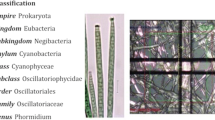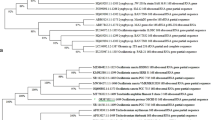Abstract
The antimicrobial activity of lipophilic extracts of mat-forming Phormidium-like cyanobacterium isolated from Egypt was investigated under different phosphate concentrations. The antimicrobial profile changed with different phosphate levels indicating metabolic changes under stressful conditions. The fractions that resulted in highest antimicrobial activity from the three different phosphate concentrations were chosen for further analyses. The bioactive compounds were identified using chromatographic and spectroscopic techniques including UV, FTIR, GC–MS and proton-NMR. The chemical analyses indicated that the compound at standard phosphate concentration was eugenol whereas the bioactive compound at half phosphate concentration was 4-tert-butylcyclohexanol. The third bioactive compound at quarter phosphate concentration was octadecanoic acid. The eugenol is known for its antimicrobial as well as pain relief properties and can be used in many pharmaceutical preparations whereas the octadecanoic acid and cyclohexanol derivative are used in some antimicrobial pharmaceuticals. The study highlights the change in antimicrobial profile of bioactive compounds derived from cyanobacteria through manipulating the concentration of a key nutrient in growth medium. This strategy can be employed for mass production of these compounds and others for future biotechnological applications.






Similar content being viewed by others
References
Abd El-Hady BA (2007) Compare the effect of polluted and River Nile Irrigation water on contents of heavy metals of some soils and plants. Res J Agric Bio Sci 3(4): 287–294. http://www.aensionline.com/rjabs/rjabs/2007/287-294.pdf. Accessed 7 Feb 2011
Ali SM, Khan AA, Ahmed I, Musaddiq M, Ahmed KS, Polasa H, Rao LV, Habibullah CM, Sechi LA, Ahmed N (2005) Antimicrobial activities of eugenol and cinnamaldehyde against the human gastric pathogen Helicobacter pylori. Ann Clin Microbiol Antimicrob 4:20. doi:10.1186/1476-0711-4-20
Barrios-Llerena ME, Burja AM, Wright PC (2007) Genetic analysis of polyketide synthase and peptide synthetase genes in cyanobacteria as a mining tool for secondary metabolites. J Ind Microbiol Biotechnol 34:443–456
Bauer AW, Kirby WM, Sherris JC, Turck M (1966) Antibiotic susceptibility testing by a standardized single disk method. Amer J Clin Pathol 45:493–496
Bhaya D, Vaulot D, Amin P, Takahashi AW, Grossman AR (2000) Isolation of regulated genes of the cyanobacterium Synechocystis sp. strain PCC 6803 by differential display. J Bacteriol 182:5692–5699
Bloor S, England RR (1991) Elucidation and optimization of the medium constituents controlling antibiotic production by the cyanobacterium Nostoc muscomm. Enzyme Microb Technol 13:76–81
Camean A, Moreno I, Verdejo T, González-Vila F, González-Pérez J (2004) Pyrolytic behaviour of microcystins and microcystin-spiked algal blooms. J Anal Appl Pyrol 74(1): 19–25. http://www.sciencedirect.com/science?_ob=ArticleURL&_udi=B6TG7-4FNDRX4-4&_user=10&_coverDate=08%2F31%2F2005&_rdoc=1&_fmt=high&_orig=gateway&_origin=gateway&_sort=d&_docanchor=&view=c&_searchStrId=1675731923&_rerunOrigin=google&_acct=C000050221&_version=1&_urlVersion=0&_userid=10&md5=7a30831e66460bf49a8e8593dcba63de&searchtype=a. Accessed 12 Mar 2011
Campbell DL, Lawton JA, Beattie KA, Codd GA (1994) A comparative assessment of the specificity of the brine shrimp and Microtox assays to hepatotoxic (microcystin-LR-containing) cyanobacteria. Environ Toxicol Wat Qual 9:71–77
Doan NT, Rickards RW, Rothschild JM. Smith GD (2000) Allelopathicactions of the alkaloid 12-epi-Hapalindole E isonitrile and calothrixin A from cyanobacteria of the genera Fischerella and Calothrix. J Appl Phycol 12: 409–416. http://www.springerlink.com/content/hj6325480n08513x/. Accessed 12 Mar 2011
Ehrenreich IM, Waterbury JB, Webb EA (2005) Distribution and diversity of natural product genes in marine and freshwater cyanobacterial cultures and genomes. Appl Environ Microbiol 71(1):17401–17413
El Semary NA, Abd El Naby M (2010) Characterization of a Synechocystis sp. from Egypt with the potential of bioactive compounds production. World J Microbiol Biotechnol 26(6): 1125–1133. http://www.springerlink.com/content/2620w7h267341h56/. Accessed 12 March 2011
El Semary NA, Ghazy SM, Abd El Naby M (2009) Investigating the taxonomy and bioactivity of an Egyptian Chlorococcum isolate. Aust J Basic Appl Sci 3(3): 1540–1551. http://www.insipub.com/ajbas/2009/1540-1551.pdf. Accessed 12 Mar 2011
Falch BS, Konig GM, Wright AD, Sticher O, Angerhofer CK, Pezzuto JM, Bachmann H (1995) Biological activities of cyanobacteria: evaluation of extracts and pure compounds. Planta Med 61:321–328
Feuillade J (1994) Studies on Lake Nantua: the cyanobacterium (blue-green alga) Oscillatoria rubescens DC. Arch Hydrobiol Beih Ergebn Limnol 41:77–93
Fish SA, Codd GA (1994) Analysis of culture conditions controlling the yield of bioactive material produced by the thermotolerant cyanobacterium (blue-green alga) Phormidium. Eur J Phycol 29:261–266
Fujise D, Tsuji K, Fukushima N, Kawai K, Harada Ken-ichi (2010) Analytical aspects of cyanobacterial volatile organic compounds for investigation of their production behavior. J Chromatogr A 1217(39):6122–6125. doi:10.1016./J.chromat.2010.07.008
Gill AO, Holley RA (2004) Mechanisms of bactericidal action of cinnamaldehyde against Listeria monocytogenes and of eugenol against L. monocytogenes and Lactobacillus sakei. Appl Environ Microbiol 70(10):5750–5755. doi:10.1128/AEM.70.10.5750-5755.2004
Höckelmann C, Jüttner F (2004) Volatile organic compound (VOC) analysis and sources of limonene, cyclohexanone and straight chain aldehydes in axenic cultures of Calothrix and Plectonema. Wat Sci Technol 94(9):47–54
Kanias GD, Skaltsa H, Tsitsa E, Loukis A, Bitis J (1992) Study of the correlation between trace elements, sterols and fatty acids in brown algae from the Saronikos Gulf of Greece. Fresenius J Anal Chem 344:334–339
Madigan MT, Martinko JM, Parker J (2000) Brock Biology of microorganisms. Prentice-Hall International Ltd, London, UK
Mundt S, Kreitlow S, Jansen R (2003) Fatty acids with antibacterial activity from the cyanobacterium Oscillatoria redekei HUB 051. J Appl Phycol 15:263–267
Ohta S, Shiomi Y, Kawashima A, Aozasa O, Nakao T, Nagate T, Kitamura K, Miyata H (1995) Antibiotic effect of linolenic acid from Chlorococcum strain HS-IO1 and Dunaliella primolecta on methicillin-resistant Staphylococcus aureus. J Appl Phycol 7:121–127
Pavia DL, Lampman GM, Kriz GS (1996) Introduction to spectroscopy. Saunders Golden Aunburst series. Harcourt Brace College Publishers, London, pp 28–30, 465–467
Raĭkova SV, Shub GM, Golikov AG, Kriven’ko AP (2004) Antimicrobial activity of new original 2-aryliden-6-furfuryliden cyclohexanones and hexahydroindazoles on their basis. Antibiot Khimioter 49(4):21–24
Ramsewak RS, Nair MG, Murugesan SI, Mattson WJ, Zasada J (2001) Insecticidal fatty acids triglycandatile components of the freshwater algae Spirogyra. J Agric Food Chem 49:5852–5856
Repka S, Koivula M, Harjumpä V, Rouhiainen L, Sivonen K (2004) Effects of phosphate and light on growth of and bioactive peptide production by the cyanobacterium Anabaena strain 90 and its Anabaenopeptilide mutant. Appl Environ Microbiol 70(8):4551–4560
Rippka R (1988) Isolation and purification of cyanobacteria. Methods Enzymol. 167:3–27. http://www.ncbi.nlm.nih.gov/pubmed/3148836
Saiz-Jimenez C (1992) Applications of pyrolysis-gas chromatography/mass spectrometry to the study of humic substances: evidence of aliphatic biopolymers in sedimentary and terrestrial humic acids. Sci Total Environ 117–118:13–25
Skulberg OM (2000) Microalgae as a source of bioactive molecules–experience from cyanophyte research. J Appl Phycol 12:341–348
Thajuddin N, Subramanian G (2005) Cyanobacterial biodiversity and potential applications in biotechnology. Curr Sci 89(1):47–57
Volk RB (2007) Studies on culture age versus exometabolite production in batch cultures of the cyanobacterium Nostoc insulare. J Appl Phycol 19:491–495
Wu JT, Chiang YR, Huanga W-Y, Jane W-N (2006) Cytotoxic effects of free fatty acids on phytoplankton algae and cyanobacteria. Aq Toxicol 80:338–345
Acknowledgments
The author acknowledges with the deepest gratitude the receipt of a Small Ecological Project Grant from the British Ecological Society-grant number 1940. The author declares the absence of conflict of interest.
Author information
Authors and Affiliations
Corresponding author
Rights and permissions
About this article
Cite this article
El Semary, N.A. The antimicrobial profile of extracts of a Phormidium-like cyanobacterium changes with phosphate levels. World J Microbiol Biotechnol 28, 585–593 (2012). https://doi.org/10.1007/s11274-011-0851-y
Received:
Accepted:
Published:
Issue Date:
DOI: https://doi.org/10.1007/s11274-011-0851-y




